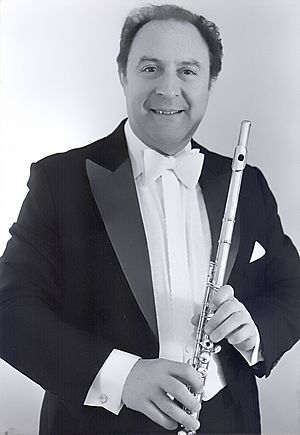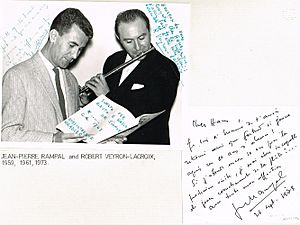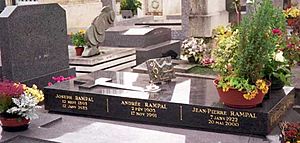Jean-Pierre Rampal facts for kids
Quick facts for kids
Jean-Pierre Rampal
|
|
|---|---|
 |
|
| Background information | |
| Birth name | Jean-Pierre Louis Rampal |
| Born | 7 January 1922 Marseille, France |
| Died | 20 May 2000 (aged 78) Paris, France |
| Occupation(s) | Flautist |
| Years active | 1940s–2000 |
Jean-Pierre Rampal (born January 7, 1922 – died May 20, 2000) was a famous French flutist. Many people say he brought the flute back into the spotlight. Before him, the flute hadn't been a popular solo instrument in classical music since the 1700s.
Contents
About Jean-Pierre Rampal
Early Life and Musical Start
Jean-Pierre Rampal was born in Marseille, France. His father, Joseph Rampal, was also a flutist. Jean-Pierre was their only child. He became the first solo flutist in modern times to become famous worldwide. He attracted big audiences, just like popular singers or pianists. His lively playing helped other flutists like James Galway become stars too.
Rampal played in the French flute style. He had a bright sound and elegant musical phrases. His playing showed a lot of emotion. He could breathe in the middle of fast music without stopping the flow. His high notes were sweet, and he could play very softly or very loudly. His quick, clear notes were also special.
Rampal is known for making the flute popular after World War II. He found many old flute songs from the Baroque time. He also encouraged modern composers, like Francis Poulenc, to write new music for the flute. These new songs are now very important for flutists.
Starting His Career
Rampal began playing the flute at age 12. His father taught him. He studied at the Conservatoire, a music school. In 1937, at 16, he won first prize in their flute contest. That year, he also gave his first public concert in Marseille. He played second flute with his father in an orchestra.
His parents wanted him to be a doctor, not a musician. They thought it was a more stable job. So, Rampal studied medicine for three years. In 1943, during World War II, the Nazis wanted him for forced labor. To avoid this, he moved to Paris and often changed where he lived.
In Paris, Rampal tried out for the Paris Conservatoire. He studied flute there from 1944. Later, he became a flute professor at the same school. After only four months, he won first prize in the conservatory's flute contest.
Success After the War
In 1945, after Paris was freed, a composer named Henri Tomasi invited Rampal to play a flute concerto on French National Radio. This launched his concert career right away. It was the first of many radio shows.
After the war, Rampal started performing a lot. First in France, then in other European countries by 1947. He often played with pianist Robert Veyron-Lacroix. They met at the Paris Conservatoire in 1946. They became a perfect musical team.
In 1949, they rented a hall in Paris to play a concert just for flute and piano. This was very new at the time and caused a "sensation." This success made Rampal want to do more such concerts. They played often on the radio and in concerts across Europe. Their first international tour was in Indonesia in 1953. In 1954, he started playing in Eastern Europe. In 1956, he played a new flute concerto in Prague. That same year, he played with violinist Isaac Stern in Canada. Stern became a close friend and helped Rampal with his musical expression.
On February 14, 1958, Rampal and Veyron-Lacroix played their first concert in the US. It was in Washington, D.C.. In 1959, Rampal played his first concert in New York City. Their partnership led to many award-winning recordings. This included all of Bach's flute sonatas in 1962. They played together for about 35 years. Later, Rampal played with American pianist John Steele Ritter.
Rampal also loved playing in groups. In 1946, he helped start the French Wind Quintet. They were friends who played music together during the war. They even broadcast music secretly that the Nazis had banned. The Quintet played until the 1960s.
From 1955 to 1962, Rampal was the main flutist at the Paris Opera. This was a very important job for a French flutist. It gave him a steady income while his solo career grew.
Bringing Back Baroque Music
Rampal's first recording was in 1946. It was Mozart's Flute Quartet. A big reason for Rampal's success was his love for Baroque music. This music was not well-known when he started. Rampal knew that to make the flute a solo instrument, he needed a lot of music to play. He realized that the Baroque era, called the "Golden Age of the Flute," had hundreds of forgotten pieces.
Before World War II, he started collecting old sheet music from the Baroque time. He looked in libraries in Paris, Berlin, and other cities. He learned a lot about the Baroque style. He studied Johann Joachim Quantz and his famous book On Playing The Flute (1752). Rampal used his energy to bring new interest to the flute. He recorded all of Bach's flute sonatas between 1947 and 1950. He was also the first to record all six of Vivaldi's Op.10 concertos.
Rampal said that Baroque music appealed to people after the war. "With all this bad mess we had in Europe during the war," he said, "people were looking for something quieter, more structured."
He used his bright tone and lively style to play these old pieces. He developed his own way of interpreting them. He never used old instruments. Instead, he used the modern flute to show the beauty of Baroque music. His clear sound and free expression made people pay attention.
The invention of the long-playing record (LP) helped Rampal a lot. Before 1950, his recordings were on 78 rpm discs. After 1950, LPs allowed him to record much more music. Television also made him famous in France.
Rampal also published a lot of the music he performed. He felt it was his "duty" to expand the music available for other flutists. He played in many different groups to keep the flute popular.
In 1952, he started the Ensemble Baroque de Paris. This group helped bring 18th-century chamber music to light.
Working with Other Musicians
Rampal recorded many "lost" concertos by Italian composers like Giuseppe Tartini and Antonio Vivaldi. He also recorded works by French composers. In 1955, he recorded flute concertos with Czech flutist Milan Munclinger. He also recorded works by C.P.E. Bach, Haydn, and Handel. He was open to trying new things. He even played all five parts in a flute quintet by Boismortier by recording over himself. Rampal was the first flutist to record most of the flute music by Bach, Handel, and Vivaldi.
He also explored music from the Classical and Romantic periods. He recorded works by Mozart, Schumann, and Schubert. He helped bring back works by other composers like Carl Reinecke. Rampal always included modern music in his concerts. In 1948, he played the first Western performance of Sergei Prokofiev's Sonata for Flute and Piano. This piece is now a favorite for flutists. He played many other 20th-century flute masterpieces.
By the early 1960s, Rampal was a famous flutist around the world. He played with many top orchestras.
He also worked with other soloists, like violinist Isaac Stern and cellist Mstislav Rostropovich. Many composers wrote music just for Rampal. These included Henri Tomasi, Jean Françaix, and André Jolivet. He also played new works by composers like Leonard Bernstein and Aaron Copland. In 1968, he even changed Aram Khachaturian's Violin Concerto for the flute. This showed he wanted to make the flute repertoire even bigger.
One special piece written for Rampal is Francis Poulenc's Sonata for Flute and Piano. Poulenc worked with Rampal to create it. Rampal called it "a pearl of the flute literature." Rampal and Poulenc first played it together in 1957. This sonata became a key part of Rampal's first US concert.
The Man with the Golden Flute
Jean-Pierre Rampal owned a special flute made of solid gold. It was made in 1869 by a famous French craftsman, Louis Lot. People had heard rumors about this golden flute for years. In 1948, Rampal bought it from an antique dealer. The dealer wanted to melt it down for the gold. Rampal realized it was a very rare and valuable instrument.
With help from his family, Rampal bought the flute. He played and recorded with it for 11 years. He said the gold made his bright sound "a little darker; the color is a little warmer." In 1958, he got a new 14-carat gold flute from the William S. Haynes Flute Company in Boston. After that, he used the Haynes flute for concerts. He kept the original golden Lot flute safely in a bank vault.
Becoming a Celebrity
Throughout the 1960s, 70s, and 80s, Rampal was very popular in the US and Japan. He toured America every year. He often played at the Mostly Mozart Festival in New York. At his busiest, he played 150 to 200 concerts each year.
His music went beyond classical. He recorded folk songs, Indian music with sitarist Ravi Shankar, and Japanese folk melodies. The Japanese album was named album of the year in Japan. He also recorded Scott Joplin rags and George Gershwin songs. He worked with French jazz pianist Claude Bolling. Their Suite for Flute and Jazz Piano (1975) was a huge hit. It stayed on the US Billboard charts for ten years.
This made him even more famous in America. In 1981, he appeared on The Muppet Show. He played "Lo, Hear the Gentle Lark" with Miss Piggy. He also played "Ease on Down the Road" in a scene like the Pied Piper.
On stage, he sometimes added fun touches. When playing Scott Joplin's Ragtime Dance and Stomp, he would tap his feet to the music.
Bolling and Rampal made more music together. Rampal also played the theme song for the movie Reds. A critic once called him "the Alexander of the flute, with no new worlds to conquer." In 1976, a New York Times critic said Rampal was "one of the great flutists in history." During these years, Rampal also continued to find and edit sheet music for flute.
His Achievements
Rampal once said the flute is "the sound of humanity, the sound of man flowing." The New York Times called him "an indisputably major artist." They praised his strong musicianship, technical skill, and amazing breath control. His tone was clear and bright, not overly romantic. Younger flutists studied his techniques carefully.
Rampal always found time to teach. He told his students to listen to all kinds of musicians, not just flutists. He believed that technique was important to express yourself. But he said, "the first quality you must have to be good... is the sound. Without the sound you cannot achieve anything."
From 1959 to 1977, Rampal taught classes at the Nice Summer Academy. In 1969, he became a flute professor at the Paris Conservatoire. He held this job until 1981. Flutist William Bennett said Rampal's fame came from his "musical sparkle and the happy personality."
His main American students include Robert Stallman and Ransom Wilson. Wilson followed Rampal's path as both a flutist and a conductor.
Family Life
Rampal married Françoise Bacqueryrisse, a harpist, on June 7, 1947. They lived in Paris and had two children, Isabelle and Jean-Jacques. Every year, they vacationed at their house in Corsica. There, Jean-Pierre enjoyed boating, fishing, and photography. He loved good food. When on tour, he always tried the local food. In 1981, he wrote an introduction to a book about sushi.
Rampal's autobiography, Music, My Love, came out in 1989.
Leaving the Stage
In his later years, Rampal conducted more often. But he continued to play the flute into his late 70s. The last important piece written for him was Krzysztof Penderecki's Flute Concerto. He played it for the first time in Switzerland in 1992.
Rampal's last public concert was in Spain in November 1999, when he was 77. His last recording was made in Paris in December 1999.
He died in Paris in May 2000 at age 78 from heart failure. French President Jacques Chirac said, "his flute spoke to the heart. A light in the musical world has just flickered out." Flutist Eugenia Zukerman said he played with "a rich palette of color" and was "a supreme poet." Carnegie Hall in New York called him "one of the greatest flutists of the 20th Century."
James Galway, another famous flutist, said Rampal was his "hero." He was amazed by Rampal's "fluid technique" and "the beauty of his tone." Galway said listening to Rampal's recordings was "a step into the stars." He also remembered Rampal's kind encouragement.
At Rampal's funeral, other flutists played music by Boismortier. This was to honor Rampal's love for Baroque music.
Jean-Pierre Rampal is buried in the Cimetière du Montparnasse in Paris.
Awards and Recognition
Rampal received many awards. These include several Grand Prix du Disque awards for his recordings. He won for his Vivaldi concertos (1954) and for concertos by Benda and Richter (1955). In 1976, he received a special Grand Prix for his entire recording career.
He also won the Edison Prize and the Prix Mondial du Disque. In 1978, he received the Leonie Sonning Prize from Denmark. In 1988, he became the President of the French Flute Association. In 1991, the National Flute Association of America gave him its first Lifetime Achievement award.
Rampal also received honors from the French government. He was made a Chevalier (Knight) of the Légion d’Honneur in 1966. He became an Officier in 1979. He also received the Order National du Mérite and the Order des Arts et Lettres. The City of Paris gave him its Grande Médaille in 1987. In 1994, he received the Trophée des Arts for connecting French and American cultures through music.
In 1994, the Japanese Ambassador gave Rampal the Order du Tréasor Sacre. This is Japan's highest honor. It recognized how he inspired new flutists in Japan. Even with his worldwide fame, Rampal felt his reputation in France had lessened. But after he died, many people praised him.
The Jean-Pierre Rampal Flute Competition started in his honor in 1980. It is held every three years for flutists from all over the world.
In 2005, the Association Jean-Pierre Rampal was created in France. It helps people study and appreciate Rampal's work. They also help re-release his early recordings.
Recordings and Videos
Rampal's first recordings were on 78 rpm discs in the 1940s. When LPs came out, he recorded for over 20 different labels. He made about 100 recordings for the French Erato label. In 1964 alone, he recorded 17 albums. In 1978, he recorded Japanese Folk Melodies. In 1979, he signed with CBS (later Sony Classical) and made over 60 albums for them.
A CD set called Jean-Pierre Rampal: Le premier virtuose moderne was released in 2002. It has rare early recordings from 1946 to 1959. The Association Jean-Pierre Rampal has re-released many early recordings.
In 2015, all of Rampal's Complete Erato Recordings were reissued. These three sets have over 40 CDs. His Complete HMV Recordings were also reissued. In 2017, Jean-Pierre Rampal in Prague was released. It included his first recordings of concertos by Benda, Richter, and Feld.
In 2022, for the 100th anniversary of his birth, Sony Classical released Jean-Pierre Rampal: The Complete CBS Masterworks Recordings. This huge set has 56 CDs. It includes his recordings from 1969 to 1996. It also has his jazz and crossover albums.
Rampal on TV and Film
Rampal appeared in many TV concerts. He was the first flutist to be widely shown on TV. This helped his popularity around the world.
- Jean-Pierre Rampal (DVD, 2007): This DVD has early performances filmed for French TV from 1958 to 1965. It shows him playing Handel, Debussy, Ravel, and Jolivet. He also plays Vivaldi and Bach concertos.
- Francis Poulenc and Friends (DVD): This compilation features Rampal playing the Poulenc flute sonata. He plays it with Poulenc himself in 1959 and later with Robert Veyron-Lacroix.
- The Art of Jean-Pierre Rampal 1956–1966 (DVD): This two-volume set shows live TV performances from Canada. He plays works by Boccherini, Haydn, Debussy, Couperin, and Mozart.
- Bolling: Suite for Flute and Jazz Piano (DVD): This shows a live TV performance from 1976 of Claude Bolling's jazz suite.
Rampal also appeared in films. He is in L. Subramaniam: Violin From the Heart (1999). He also appears in the educational film The Joy of Bach (1977), playing his flute on a rooftop in France.
Images for kids
See also
 In Spanish: Jean-Pierre Rampal para niños
In Spanish: Jean-Pierre Rampal para niños





